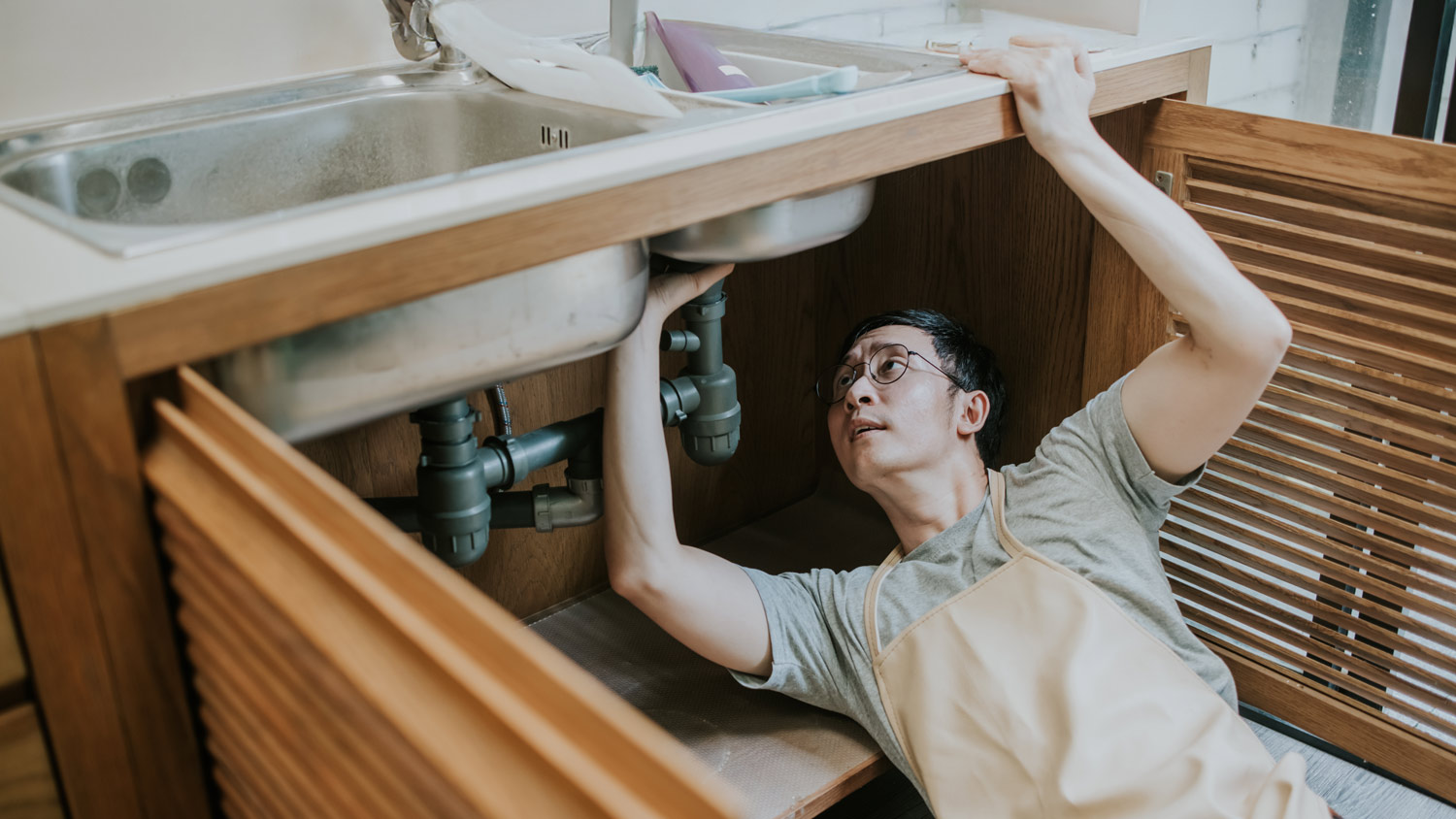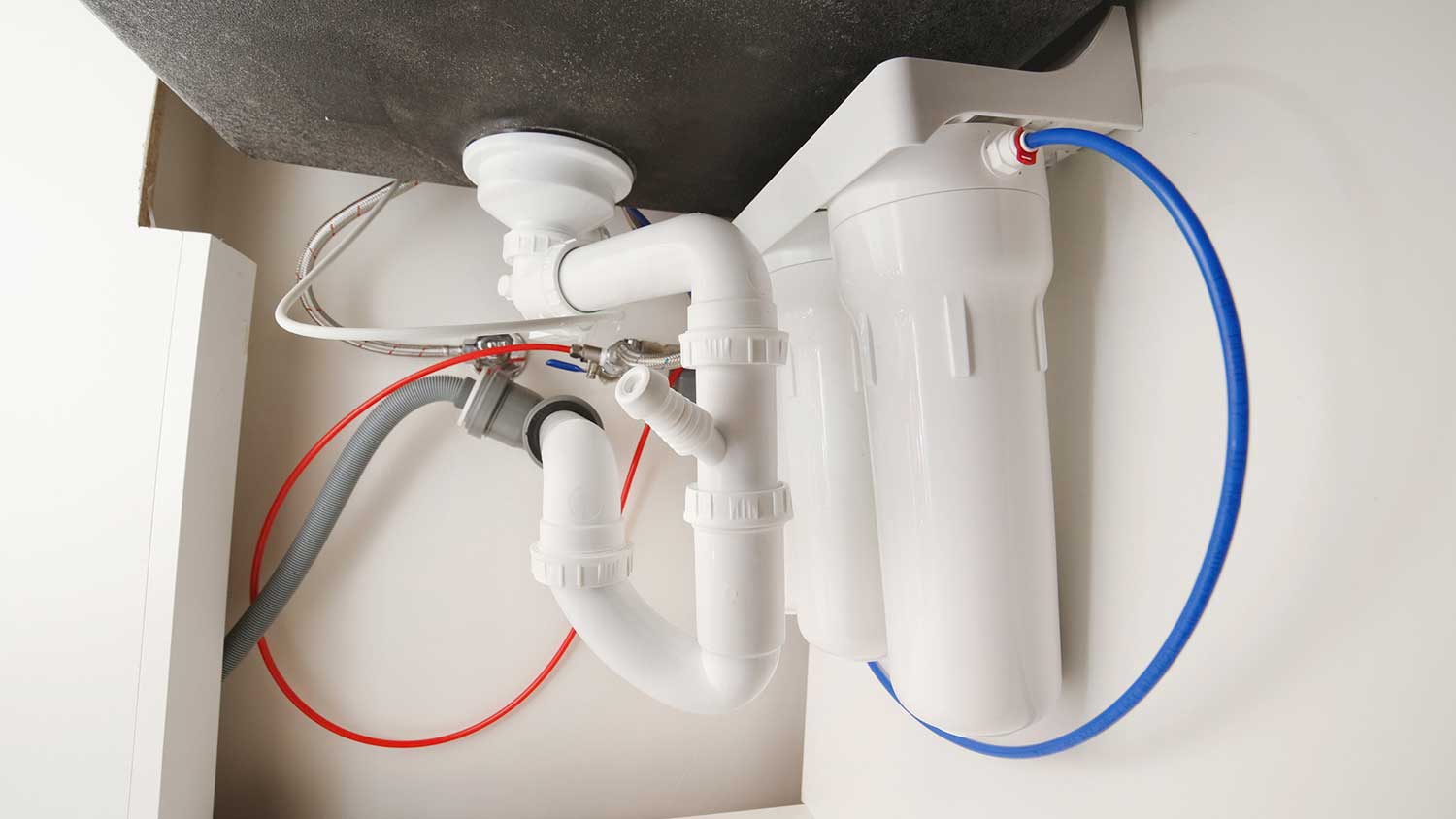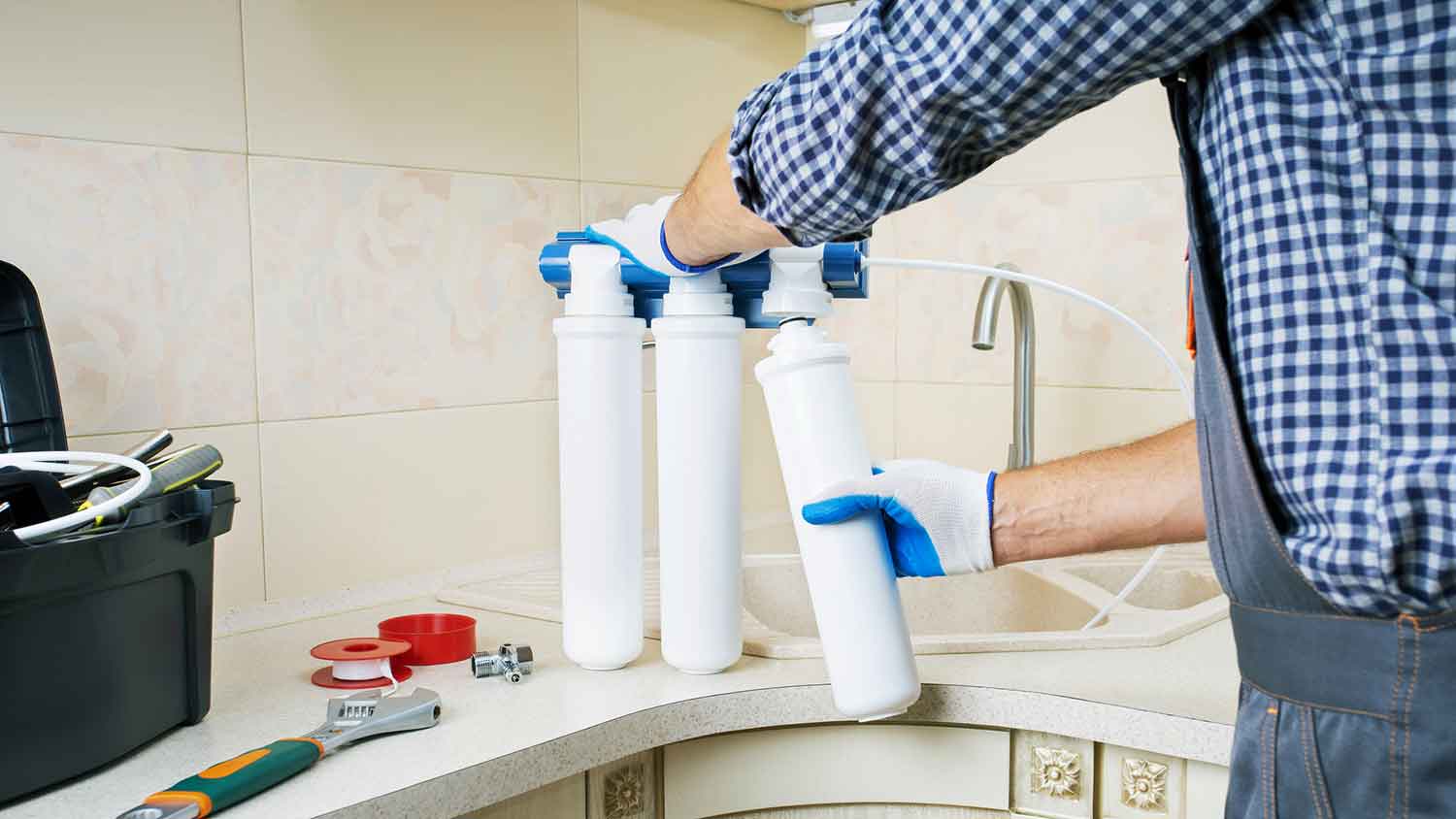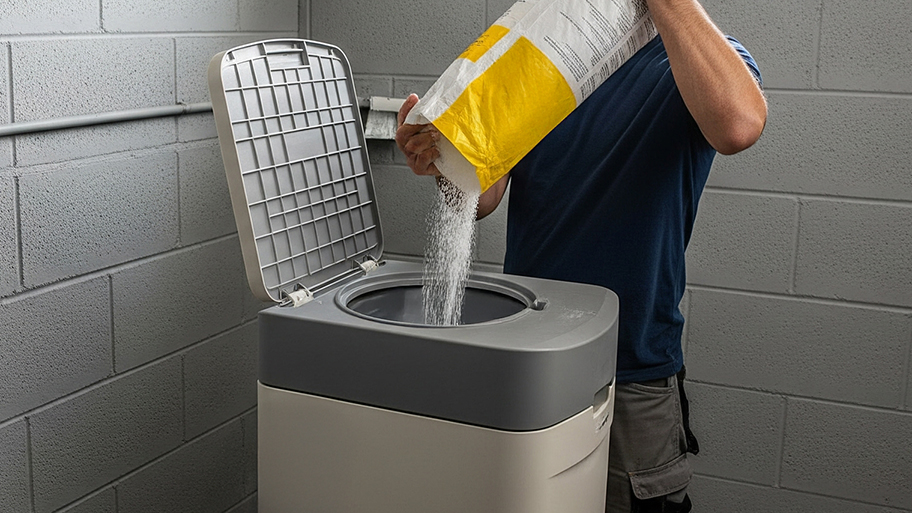
Your cost to install an under-sink water filter will depend on the type and size of system you choose and whether you need professional installation.
Water softener service costs depend on your project and location. Check with a local pro for your specific job.
It costs $2,200 on average to install a reverse osmosis system.
A point-of-use system will cost as little as $200, while whole-home units cost as much as $4,800.
Expect to pay between $175 and $600 annually for system maintenance, which includes new filters, membrane replacement, and periodic plumbing services.
Expect to pay $150 to $300 for installation labor.
The main difference between soft water and hard water is the mineral content. Hard water has higher levels of calcium and magnesium, whereas soft water has undergone a process to remove these minerals.
Installing a reverse osmosis water filter costs an average of $2,200, but it’s best to budget $1,000 to $4,800 for this project. A reverse osmosis system can soften your water by removing minerals such as calcium and magnesium, but that's not its main job. This type of system is designed to remove a broader range of impurities.

The price of your reverse osmosis (RO) water filter depends on several factors, including the type of water filter and the efficiency of the system. Let’s break down these variables to give you a better idea of how much you’ll pay for your system.
There are two main types of RO systems: whole-house and point-of-use. Whole-house RO water filter systems (also known as point-of-entry systems) are installed at your home’s main line, where they treat all of the water coming into your house. While these are great at filtering all water that enters your home, they can be overkill for some who only need RO-filtered water at certain faucets.
On the other hand, point-of-use systems treat water at a single water fixture (for example, a kitchen sink or refrigerator). These are excellent choices if you primarily drink from one water fixture, don’t want to swap filters regularly, or want to avoid investing in a large, whole-house RO system.
As you might expect, whole-house systems cost more than point-of-use filters. Here’s what you can expect to pay for each type:
| System Type | Average Cost |
|---|---|
| Whole-house | $1,000–$4,800 |
| Point-of-use - Countertop | $200–$700 |
| Point-of-use - Undersink | $200–$800 |
| Point-of-use - Tankless | $250–$900 |
The purpose of reverse osmosis water filter systems is to produce clean, drinkable water, but they also generate significant amounts of wastewater in the process.
According to the Environmental Protection Agency (EPA), a point-of-use RO system wastes 5 gallons of water per gallon of treated water. Some newer systems are more efficient, reaching a one-to-one ratio of wastewater to filtered water, but they cost about $300 more than less efficient products.

Reverse osmosis systems have multiple filtration stages (often between three and seven), each of which serves a different function. For example, the first level might remove sediment particles, while the second one extracts carbon from the water.
As you compare RO systems from the same company, you’ll notice that products with more filtration stages are often pricier than ones with fewer stages. However, this isn’t always true because a four-stage RO water filter from one company could cost less than a seven-stage filter from another.
Keep in mind costs will differ between point-of-use and whole-house systems, too. Explore average starting prices for point-of-use reverse osmosis filters based on the number of filtration stages:
| Number of Stages | Average Starting Cost |
|---|---|
| 3 | $190+ |
| 4 | $210+ |
| 5 | $230+ |
| 6 | $280+ |
| 7 | $300+ |
Different filters have different flow capacities. Which one you choose will depend on the water usage in your home, which can be estimated based on the number of people living in the home. If you don’t have any exceptional water needs, the average person uses around 175 gallons per day. Not all of this is water that’s required to be filtered, though (for example, you don’t need to filter toilet water).
Expect to pay more for larger units with more filtration capacity. However, the cost may remain the same over the filter's lifetime. Larger units cost more, but if the system wears less, you’ll save on filter replacements. Talk to a pro to determine the right size of system your household needs.
On average, it costs between $300 and $700 to hire a professional to install a reverse osmosis water filter system. Your price will depend on a few factors, including labor rates in your area and the size and complexity of your RO system. For example, you might only pay $100 to $300 to install a point-of-use system, while a whole-house system could cost closer to $1,500.

In addition to the upfront costs of installing a reverse osmosis water filter, there are ongoing expenses to consider. Here’s what to expect.
Filters need to be replaced at least every year, but it’s a good habit to swap them once every six months. The good news is they aren’t complicated to replace and are relatively inexpensive. A set of RO filters will cost between $40 and $90, but it can be quite a bit more if you have a large system or one with special filters. In that case, budget between $100 and $300 per year for replacement filters.
The RO membrane is separate from the filters but is an integral part of the system. On most systems, the membrane will look similar to a filter but will be installed horizontally on top of the filters. You should replace the membrane every two to five years, which will add $30 to $100 to these costs.
For the most part, your RO water filter system should run pretty seamlessly. However, to keep it in good shape, you’ll need to perform periodic maintenance, like checking for leaks and cleaning and sanitizing the system annually. You can do this for free by following the instructions in your user manual.
Otherwise, you can call in a plumber or water filtration professional (which you might need to do anyway if you find any leaks or other issues while inspecting your system). On average, hiring a plumber costs between $45 and $200 per hour.
It’s possible to install a small reverse osmosis filtering system to your home yourself, but for larger, whole-home systems, it’s always better to bring in a local water softener installation company instead. These pros know their way around filtration systems, ensuring all the complex plumbing work is completed to a high standard. Considering professional labor for this task costs just $150 to $300, we always recommend working with an expert for this task.
Working with an expert to install a water filtration system has a few key benefits, such as:
Proper completion of all plumbing tasks, such as water connections and piping
Guarantees and warranties on your installation
Get specialized filtration for the specific impurities in your water supply
Ensure a proper installation of the entire system
If you’re installing a new point-of-use RO system in your kitchen, you might want to tackle other kitchen plumbing projects at the same time.
Cost to install a new dishwasher: $200–$3,500
Cost to replace a garbage disposal: $200–$625
Cost to add a refrigerator water line: $75–$130
Cost to install a sink: $200–$650
Cost to add a hot water dispenser: $300–$600
Cost to add UV filtration: $200–$500
Cost to add booster pump: $50–$300
Cost to add alkaline remineralization kit: $150–$300
As we’ve mentioned, installing your own small point-of-use RO system is one way to reduce costs. Other money-saving options include:
Buying a refurbished system: You’ll spend less upfront if you buy a refurbished reverse osmosis water system instead of a new one. However, you’ll want to confirm that the system is still in good condition and covered by a warranty before making a purchase.
Opting for an energy-efficient model: To keep operational costs down and reduce water usage, invest in an energy-efficient RO system.
Comparing brands and prices: There are many RO systems for sale online from home improvement stores and online retailers. Take the time to research different brands and products to find the right model for your needs—and get the best deal on it.
Requesting multiple quotes: Installation prices vary by company. Gathering several estimates will let you compare rates and find the most competitive offer.
Using a home water filtration system and filling a reusable bottle can provide significant cost savings and environmental benefits over plastic bottled water.
Determine whether you need a point-of-use or whole-house system—your pro can advise based on your needs
Have your professional perform a water test to determine what may be in your water supply
Don’t forget to factor in capacity for larger households—an expert can help you choose the right system size
Ask if your professional offers ongoing maintenance or warranties for your new RO system
From average costs to expert advice, get all the answers you need to get your job done.

Your cost to install an under-sink water filter will depend on the type and size of system you choose and whether you need professional installation.

How much a water softener costs depends on your home’s size, and the system’s type and capacity. Our expert guide explores all the price factors.

Wondering about water treatment system costs? Learn average prices, key cost factors, and ways to save on installation and maintenance for your home.

Knowing how to fix a clogged water softener will help you spot and stop a blockage so that soft, purified water always flows.

While not all symptoms of too much chlorine in water are cause for concern, there are times when you should call a pro. Get the details in this article.

Having an issue with your water softener? Learn the parts of a water softener and how they work together to treat hard water with this guide.